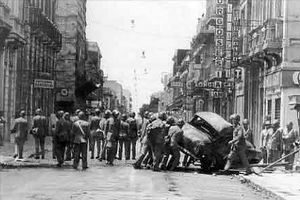
Reggio revolt
The Reggio revolt occurred in Reggio Calabria, Italy, from July 1970 to February 1971. The cause of the protests was a government decision to make Catanzaro, not Reggio, regional capital of Calabria.[1][2] The nomination of a regional capital was the result of a decentralization programme of the Italian government, under which 15 governmental regions were concretized and given their own administrative councils and a measure of local autonomy.[3]
Reggio revolt
5 July 1970 – 23 February 1971
Decentralization and the choice of Catanzaro as the region capital
Recognition of Reggio Calabria as capoluogo (regional capital)
Strikes, street rioting and road and railway blockades
- Repression of the riots
- Establishment of the Regional Council of Calabria in Reggio
- Regional development (a railroad stump, the steelwork center, and the port in Gioia Tauro)
According to official figures of the Italian Ministry of the Interior there were 3 dead; other sources mention 5 dead
According to official figures of the Italian Ministry of the Interior there were 190 policemen and 37 civilians wounded; other sources mention hundreds of wounded
Arrest and imprisonment of the revolt's leaders, like Francesco Franco
Aftermath[edit]
In October 1972, the main left wing labour unions led by the Italian General Confederation of Labour organized a conference in Reggio to regain their influence. Twenty trains were chartered to bring workers from northern and central Italy. On one of the trains full of workers and trade unionists a bomb exploded leaving five injured. Two other bombs burst on the rails in the vicinity of Lamezia Terme, while other unexploded bombs were found along the same railway line.[8] Despite the attacks, many did reach Reggio to attend the conference and street march. Franco was investigated for distributing leaflets hostile to the anti-fascist demonstration.[21] Subsequent judicial investigations of charges of provocation and terrorism ended with his acquittal.
The steelworks was never built,[2] but a conflict between different 'Ndrangheta groups over the spoils of public construction contracts to built a railroad stump, the steelwork center, and the port in Gioia Tauro, led to the First 'Ndrangheta war.[22]